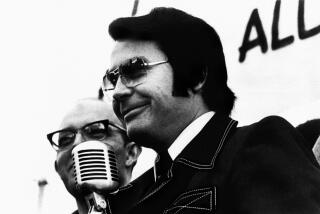‘Tis a gift to be simple, but ‘tis a gift to be small? : A Shaker community is down to 8 members, but it’s the same number that began sect in the U.S. in 1794.
- Share via
NEW GLOUCESTER, Me. — A vacuum cleaner hummed in the background and two dogs pranced at his feet as Brother Arnold Hadd led the way inside a century-old brick dwelling house at Sabbathday Lake.
At first glance, the casually dressed, 38-year-old Hadd hardly fit the image of a custodian of a rich religious tradition and American cultural phenomenon that threatens to slip into the past.
But Brother Arnold, as elder of the Shaker society at Sabbathday Lake, and the seven other society members say that role is one they feel keenly these days. As the last active community of a Protestant sect that in the 1850s encompassed 18 societies and 6,000 people, the Sabbathday Lake Shakers--who this year celebrated their 200th anniversary--say they feel a special duty to ensure that their religion endures.
“There’s a certain burden on us to live the life as absolutely authentically as possible,” said Brother Arnold, who along with Sister Frances Carr administers the community, located on an estate of 18 buildings and 80 acres of working farmland.
For the community members, authenticity does not mean donning the same garb as their ancestors or eschewing modern conveniences. It does mean holding true to the basic rules of Shaker life, including celibacy and communal ownership of wealth, and to the sect’s core teachings, such as the value of hard work.
“It’s a very difficult life,” Brother Arnold said recently. “It requires a very mature person to be able to commit themselves.” But, he added, “I feel more fulfilled here spiritually than I ever felt anywhere.”
Yet there are worries he and others feel about the future of their community--and their faith.
“We would be naive if we said it doesn’t concern us,” Sister Frances said of the potential demise of a sect whose finely crafted furniture, songs and utopian way of life are still firmly embedded in the American mind.
But she said she takes heart that Sister Ann Lee, the charismatic leader of the original Shakers, fled to America from Britain in 1774 with eight followers--the same number that now exist at Sabbathday Lake.
“A lot developed out of that,” Sister Frances said. “While we don’t expect such a resurgence, who is to say what will happen in the next few years? Certainly, there’s a great deal of interest being shown in everything about Shaker life.”
While minuscule, the Sabbathday Lake community need not fade into history since, unlike some other Shaker societies, it has always accepted new members, Sister Frances points out.
Worrying about the future is not a luxury the Sabbathday Shakers often have. With a 1,800-acre estate to maintain, the society’s six women and two men, ages 30 to 87, are seldom idle.
Sister Frances takes charge of cooking and shopping. Others tend to the gardens and a flock of sheep, work in the print shop or create handcrafted goods.
For income, the community sells 38 varieties of herbs that it grows and packages, along with lumber and gift items. It also leases property. And it grows much of its own food.
Unlike the Pennsylvania Amish, the Shakers make use of technology, both new and old. While wood stoves provide the main source of heat in the dwelling house, there is a dishwasher and a microwave oven in the kitchen and a personal computer in the office.
But Shaker traditions seem hardly threatened by such modern efficiencies. In addition to celibacy and common ownership of goods, the community carries on the Shaker custom of private confession among members.
Daily life still follows a monastic routine. Members are summoned by bell to breakfast at 7:30 each morning, with prayers following the meal. Prayers also accompany a noon meal. Religious services are held on Wednesday nights and Sundays.
For inspiration, the Shakers need only look at the pictures lining the walls of the leaders who guided the community during its heyday.
Founded in 1747 in Britain, the Shakers--so named because members often violently shook during worship--settled in Albany, N.Y., in 1776.
Despite renewed persecution, the movement claimed new members in the late 18th and early 19th centuries, forming communities throughout New England, as well as in Ohio, Indiana, Kentucky and Pennsylvania--and later in Florida and Georgia.
The Sabbathday Lake community, founded in 1794, at one time had more than 50 buildings. The bustling community operated a grist mill, manufactured wooden items such as tubs and barrels, produced woven goods, raised garden seeds and medicinal herbs, ran a school and cared for orphans.
But like other utopian movements, Shakerism saw its numbers decline. By the 1940s, just four communities remained.
While their numbers are small, Shakers still have a relevant message for today’s world, Brother Arnold said. “This is still a viable way of life. I personally feel very ordinary people can be made to do extraordinary things through this life.”
More to Read
Sign up for Essential California
The most important California stories and recommendations in your inbox every morning.
You may occasionally receive promotional content from the Los Angeles Times.













